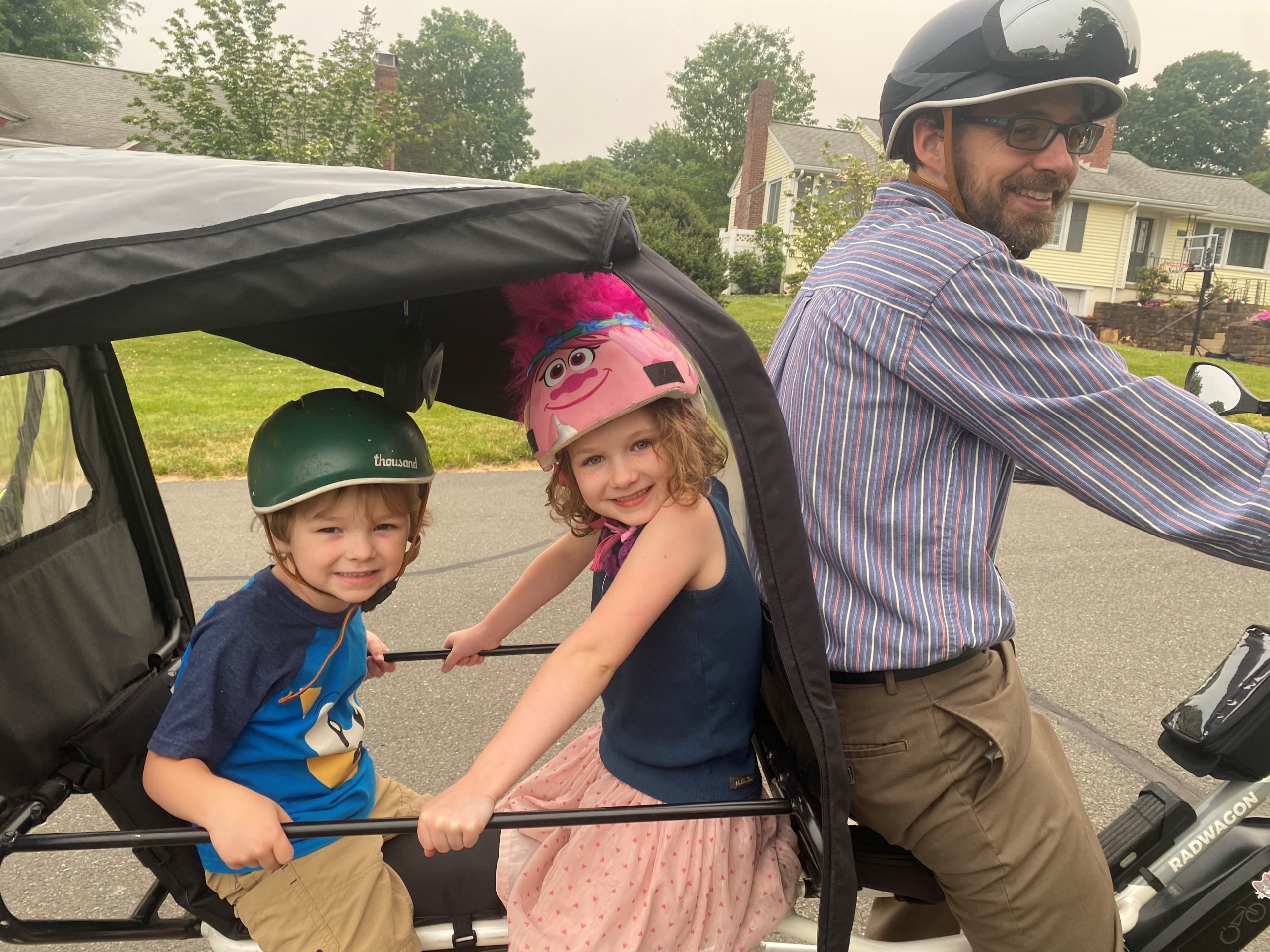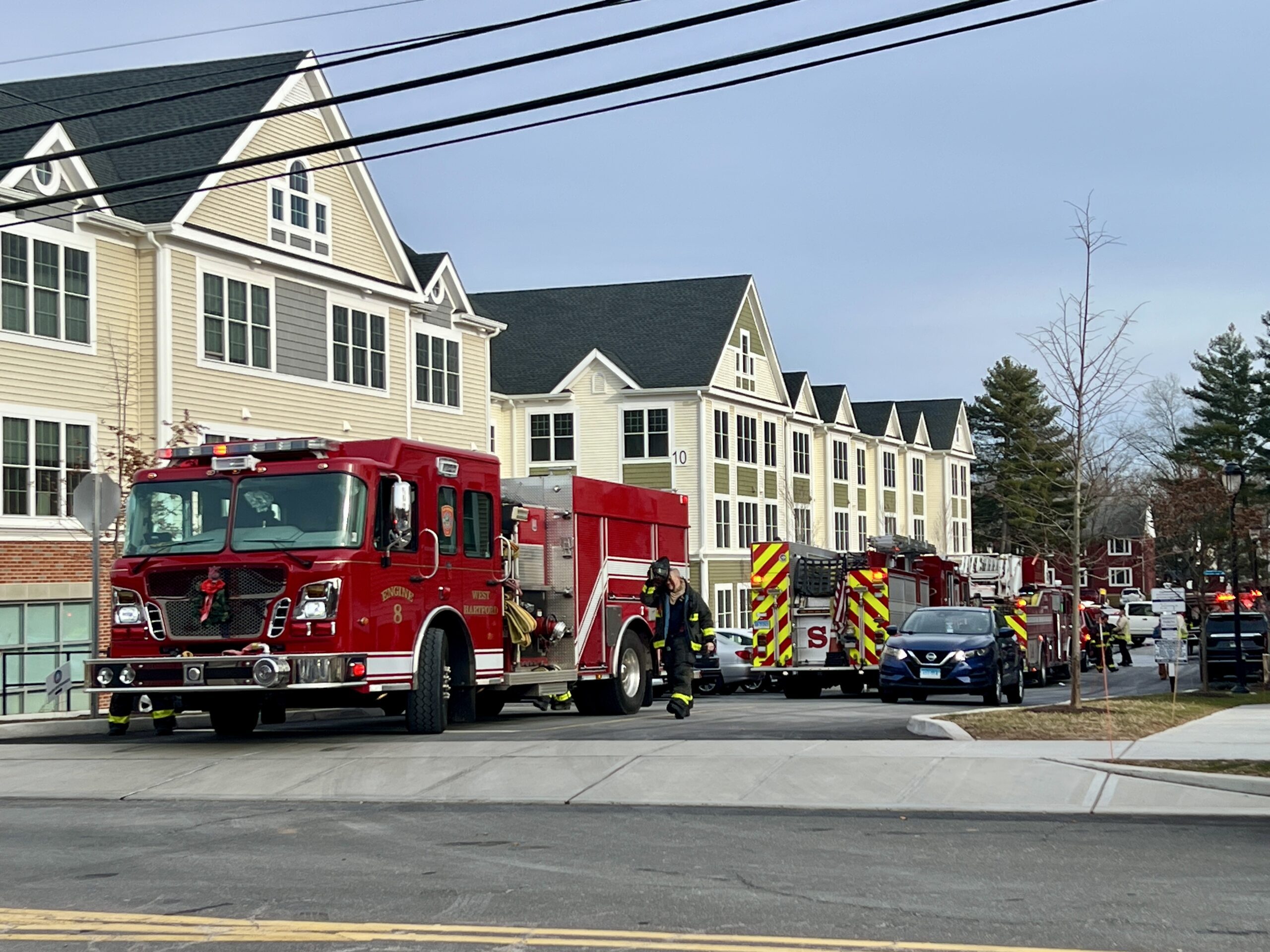Op-Ed: The World is Changing, Will West Hartford Change With It?

Audio By Carbonatix

Jim Head and his children, Maggie (8) and Jamie (5) excited for another e-bike trip. Courtesy photo
Resident and Bike West Hartford Board member Jim Head urges town leaders to consider facts and best practices before finalizing the West Hartford Center Infrastructure Master Plan.
By Jim Head
The Town of West Hartford recently revealed the latest plans for West Hartford Center and people are now talking. For anyone just now joining the conversation, here are some key events that occurred during the West Hartford Center Master Plan timeline:
- After several road fatalities in 2022 including one in the Center, the town committed to developing and following a Vision Zero action plan with the goal of eliminating fatalities and serious injuries on West Hartford streets by 2033, adopted earlier this year.
- Also in 2022, the Town hired consulting group Stantec to work on the re-design of West Hartford Center. That fall, Stantec polled residents and created an interactive map of the entire town for people to identify areas of concern, areas that felt safe, and ideas for improvement. This map was flooded with red thumbs down emojis and commentary on how various areas felt unsafe.
- In the fall of 2023, using feedback received through this process initiated in 2022, Stantec presented a draft plan for the re-design project. Certain stakeholders, including some businesses in the Center, strongly opposed that plan, which proposed extending the sidewalk, shrinking the width of travel lanes on LaSalle and Farmington, changing angle-in parking to parallel parking, offering off-street sidewalk-level bike lanes on Farmington Avenue, improving crosswalks, and improving greenery. The primary two concerns were how disruptive the construction would be to business and how many on-street parking spots would be lost in the re-design.
- In February 2024, another survey was released asking for additional feedback on the Center re-design.
- April 8th, the draft plan was revised – removing bicycling lanes altogether, keeping angle-in parking, making smaller gains on sidewalk widths, adding dedicated loading zones during specific hours, and improving crosswalks and greenery.
In short, West Hartford leaders hired consultants to research the area and propose a re-design, and in the face of pushback from the first proposal, worked with those same consultants to re-survey and find reasons to scale back. In the past four years, I have heard a lot of “Listen to the experts” – Why doesn’t this apply here? What is the actual logic behind the re-re-design? As far as I can tell, it’s fear of change, uses the past to dictate the future, and ignores how the world is changing.
One argument I hear a lot of: “Nobody bicycles in town so why do we need bike lanes?”
People want to ride their bikes in town but don’t feel safe doing so. I hear this a lot, especially from neighbors new to the area. They’ve moved from more progressive communities where they’ve already benefited from pedestrian and bike-friendly changes and struggle to understand why change here is so slow-going.
More people can ride bikes now than ever. I appreciated the town historian’s article from 2012, discussing the advocacy work done by bicyclists as far back as the 1800s. It’s not a new concept, however bikes have changed and continue to accommodate more types of users. I’m new to cycling in town as of 2020. Why? E-bikes. Running is my passion – it’s how I’ve always preferred to exercise. I did own one bike prior to 2020 but rode it very infrequently. I sold it when I got my e-bike and have no regrets getting rid of it. My e-bike, however, has become my car-replacer. It carries my kids to school, a week’s worth of groceries, my work bag and lunch to Hartford where I work. Since fall of 2020, I’ve now put 8,600 miles on it.
E-bikes continue to outsell EVs in the United States. People who stopped riding a bike years ago are getting e-bikes. A friend of mine (not a cyclist as of yesterday) ordered and is receiving their first e-bike this Friday. E-bikes are not new, but they are now becoming mainstream. The electric assist allows the user to work as hard as they choose to – it’s how I can ride 10 miles to school drop-off and then the office without breaking a sweat. The battery uses 1/100th the material found in an EV and costs pennies to charge.
West Hartford, with its mild winters, moderate hills, and dense population would be an ideal place to ride an e-bike if it weren’t for the lack of cycling infrastructure. I grew up in a rural town with a total of two grocery stores spaced far apart – here in West Hartford there are countless places to shop within only a few miles, most a 15-minute or less bike ride away.
Another argument against change: “If we lose parking spaces, we’ll lose business.”
Multiple cities have made areas more pedestrian-friendly at the cost of reduced parking and it’s become clear that it’s not the cars that are shopping. I too read “StreetFight,” referenced in Jason Wang’s recent Op-Ed. When streets in NYC were made more people-friendly, businesses in those areas performed better, not worse. For a more local and smaller scale example, Pratt Street in Hartford appears to be doing well since being closed off entirely to cars.
In this case, Stantec’s original proposal did not go nearly as far as Pratt Street. Both Farmington Avenue and LaSalle would be open to cars and street parking would still exist – as stated in another op-ed, the spaces lost represent 0.6% of all West Hartford Center parking spaces, which are currently 30% to 60% utilized per Stantec’s own analysis.
As it is today, I rarely go to the Center. I used to go to the Halloween Strolls, but the last Halloween Stroll I attended, people were spilling into the street. The sidewalks weren’t wide enough to accommodate all the candy tables and parents and strollers and kids in costumes. I’m not so concerned my children would go running into the street, but it’s very stressful crossing parking lot entrances and in the sections of sidewalk where drivers are zooming by, frustrated at having to wait at multiple crosswalks. I honestly don’t understand why the streets can’t be even partially closed for the four hours to accommodate a more family-friendly environment.
This brings me to the angle-in parking. Cars are getting bulkier and not all cars have the same safety features. Back-out cameras don’t have a wide view. The representative at the latest Master Plan meeting said something to the effect of “people who are comfortable biking on Farmington Avenue are certainly welcome to do so” when asked if the latest design really had no bike lanes whatsoever. I’m not comfortable riding behind a row of angle-in parked cars, and I certainly wouldn’t let my height-limited kids ride on a street like that. Added to this concern, bikes are prohibited from being ridden on the sidewalks specifically in and around the Center. Of course business owners in the Center rarely see a bike today – that’s by design, not because “nobody wants to ride a bike.”
Across the world, more people are riding bikes places for a lot of great reasons – to be healthier (yes, even e-bikes have proven to have significant health benefits), to save money on gas, to get places faster than walking or outside of comfortable walking distances, to reduce ones impact on the air and climate. Two extreme examples – London and Paris recently reported having more cyclists than motorists. These places are not Amsterdam; in Paris, for example, only 3% of trips in the city center were by bicycle as of 2010 – the increase in cycling occurred recently and not without vision and commitment from city leadership.
One last concern from the original proposed plan: “What disruption will all this construction cause for my business?”
The town did address this by planning the project in phases, working on part of one side of a street at a time. I have no issues with this. I will note I have a much easier time navigating construction zones on my bike than in my car. If done well, with appropriate consideration for sidewalk access, the construction could cause less disruption to those that are car-free.
There will always be pushback. Change can be hard – instead of letting fear guide decisions I’d urge town leaders to consider facts and current best practices. West Hartford is not the first town to propose improvements like this, there are stories of other towns worth looking at and learning from.
Jim Head is a West Hartford resident and Bike West Hartford board member
We-Ha.com will accept Op-Ed submissions from members of the community. We reserve the right to edit all submitted content.
Like what you see here? Click here to subscribe to We-Ha’s newsletter so you’ll always be in the know about what’s happening in West Hartford! Click the blue button below to become a supporter of We-Ha.com and our efforts to continue producing quality journalism.




Thank you so much Jim for this excellent letter. People do want to ride. And e-bikes re-open biking to older people who feel like their riding days are done.
So many studies show how bad angled parking is.
I know that the Town Manager and Mayor and Town Council want what is best for the town and, in the past have been responsive to advocacy for the good of its citizens. The world is changing and I hope they can see their way to engaging with people who want the center to be more pedestrian and bike friendly.
When my family first moved to West Hartford in 2020, we joined tons of other families walking during those pandemic times to eat in town center restaurants, which had expanded to sidewalks instead of folding up and dying. While walking, we explored other businesses and made them part of our routine. Town staff and Mayor Cantor worked hard to make all that happen. They put in the overtime to make sure the restaurants didn’t close up during Covid. It would be a shame to see all that good work rolled back up to make room for a few parking spots in front of Town Center businesses, which is the current plan proposed for LaSalle and Farmington Town Center street rebuilding. Please reach out to Town Council members and Town Manager Rick Ledwith and let them know Town Center is not just for cars, it’s for people. Make the expanded dining space permanent with beautiful new tree wells and wider sidewalks. Buffer outdoor diners from headlights and engine noise with parallel parking. Angled parking takes 18 feet instead of 8 feet. It’s a waste of our towns most valuable public space and it’s bad for business. There are already more than 5,000 parking spaces, thousands underutilized, in Town Center. Restaurants and families walking and bicycling safely together are a much better use of public space in the Center than car storage.